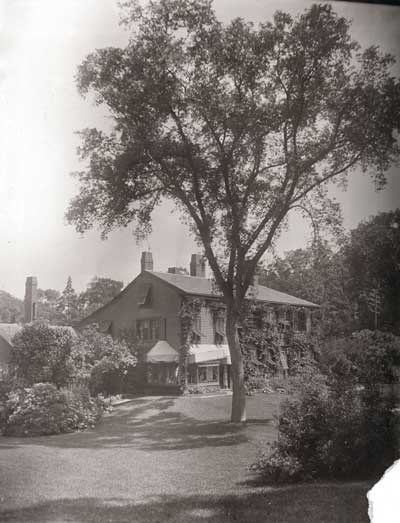|
Learn about more plants at Fairsted, and check out our Plant Chats with Val

The "Olmsted Elm", which was planted circa 1810, was a main stay in the Fairsted landscape for generations. In recent history, the elm's health seriously declined and, as a result, its structural stability was compromised. Symptoms included crown dieback, shedding of bark and branches, spreading infections of wood and root decay fungi, and the widening of a vertical seam along the main trunk. Together, these symptoms increased the risk of tree failure and potential damage to the adjacent Olmsted house. 
Olmsted Archives 
Olmsted Archives
Working with the Arnold Arboretum of Harvard University, Olmsted NHS staff took cuttings from the existing tree for propagation of genetic clones;hoping that if one reached adequate size and vigor, it would be planted in the same place as the original.For more than a decade, the NPS worked with the Arnold Arboretum, but regrettably the clones either failed to thrive or themselves became victims of Dutch Elm Disease, which had also afflicted the historic elm. While attempts to replace the tree with this propagated material were unsuccessful, the NPS continued to employ techniques to promote the replacement elm's growth in a manner that approximates the aesthetic features of the original. As a result, the NPS planted a disease-tolerant American elm variety there instead. Again, this celebration was captured on video.
The new tree is a "Jefferson Elm," a cultivar that typically develops the classic vase-shape that characterized the historic Olmsted elm and also has shown resistance to Dutch Elm Disease. Turning to research to find a suitable replacement, the Jefferson Elm cultivar was chosen.Developed by the National Park Service and the U.S. NationalArboretum, and drawn from a thriving elm planted on the National Mall in the 1930's, in addition to its other virtues, the cultivar has an association with Frederick Law Olmsted Jr., who had a significant role in planning the Mall when he was a member of the 1901 McMillan Commission. Transcript
There are no words to this time-lapse video of the removal of the Olmsted Elm.
Visit our keyboard shortcuts docs for details
Frederick Law Olmsted National Historic Site bid farewell to its "Olmsted Elm" on the morning of March 30th. The tree had to be removed due to it hazardous condition. The National Park Service hopes to replace the elm with a genetic clone derived from the original tree once the ground has been prepared and one of the several clones, or propagules, has reached sufficient size. The removal of the Olmsted Elm was captured on this time-lapse video.
Visit our keyboard shortcuts docs for details
Watch and welcome a new elm to Fairsted's South Lawn! |
Last updated: March 1, 2024
